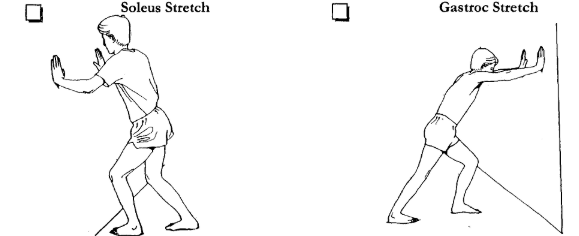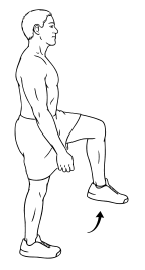Plantar Fasciitis is one of the most common causes of heel pain. It normally feels like a stabbing pain most notably as you first step out of bed in the morning. As you get moving the pain often dissipates but may return after long periods of standing or when you stand up after long periods of sitting. It can feel worse after exercise but may not be noticeable during a workout.
In today’s episode of the Willpower Not Required Podcast, I will be talking about plantar fasciitis, the common causes and some stretches to improve or prevent it. This is for informational purposes only. It is important to first speak with your health care provider if you are experiencing any type of pain. Do not attempt to diagnose or treat yourself. Pain is the way your body communicates with you. It is telling you that something isn’t right…don’t ignore it.
Watch the podcast or continue reading below.
What is Plantar Fasciitis
The plantar fascia is a thick band of tissue that runs along the bottom of your foot. It connects your heel to the base of your toes and acts like a shock absorbing bow string in the arch of the foot. If too much tension is placed on the plantar fascia, over time it can become irritated or inflamed resulting in heel pain known as Plantar Fasciitis.
If left untreated, chronic irritation can cause a heel spur -a bony protrusion on the underside of the heel bone. In addition, if you find yourself changing the way you walk in order to reduce the pain, it can lead to foot, knee, hip or back problems.
Risk Factors for Plantar Fasciitis
Plantar fasciitis can develop without an obvious cause, however there are some factors that can increase your risk such as:
Poor foot mechanics
Flat feet or high arches can cause abnormal weight distribution putting strain on the plantar fascia.
High Heels
Wearing heels too often can cause the Achilles Tendon (the tissue that connects the calf muscle to the heel bone) to shorten and place tension on the plantar fascia.
Speaking of the Calf Muscle – tight calves pull on the Achilles Tendon which in turn pulls on the plantar fascia.
Overuse Activities
Overuse activities, like distance running, dancing or jobs that require long periods of standing put more stress on the feet and without proper flexibility and mobility training can lead to plantar fasciitis.
Exercises for Plantar Fasciitis
Exercises that focus on stretching the muscles in the lower leg and reducing tension in the Achilles Tendon and plantar fascia can help to prevent or improve plantar fasciitis.
In addition, strengthening the muscles in the foot as well as around the ankle and in the lower leg will help support the foot and take undue pressure off the tendons and ligaments.
The following exercises may be helpful, however please consult your health care provider before attempting any new exercises. Stop performing the exercises if pain does not improve or gets worse.
Calf Stretches
Stretch the muscles that make up the calf (the gastrocnemius and soleus muscles)

Soleus Stretch
- Stand facing a wall with both knees bent, toes forward.
- Stagger your stance so one leg is closer to the wall. The leg that is further away from the wall will be the one that will be focused on.
- Gently lean into the wall until a stretch is felt in the lower calf of the back leg. Hold for 30s or more
- Repeat on the other leg
Gastrocnemus Stretch
- Remain in the same stance as for the soleus stretch
- Straighten the back leg then lean into the wall until a stretch is felt in the back of the rear leg below the knee.
- Hold for 30s or more then repeat on the other leg
Foot Stretch
Stretch the intrinsic muscles in the foot.

- Sit with your legs crossed – the left ankle on top of the right knee.
- Pull the toes of the left foot upwards until a stretch is felt.
- Hold for 30s or more then repeat on the other foot.
Myofascial Release
Using a tennis or lacrosse ball, perform massage or myofascial release on the plantar fascia.

- While sitting in a chair place a tennis ball or lacrosse ball underneath your foot.
- Apply gentle pressure onto the ball and slowly roll your foot over the ball to massage the painful area.
- If you feel a spot that is particularly tight, pause there to allow it to release.
- Perform for 1 minute.
- Repeat on the other foot.
Foot Strengthening Exercises
Strengthen the muscles in the arch of the foot by performing towel curls with a face cloth or hand towel

- Place a facecloth or towel on the floor and your foot on top of it.
- Slowly bunch the towel up with your toes as you curl them.
- Repeat 3-5 times then repeat on the other foot
Balance Exercises
Performing balance exercises that strengthen the muscles that support the ankle, knees and hips will improve standing, walking and foot mechanics.



The body is an amazing machine and compensates for an issue in one area of the body by recruiting other muscles to help out. Even though these muscles are super helpful, they are being asked to do a job that they were not designed for.
Protect the plantar fascia by taking the time to improve and maintain mobility and flexibility in the lower leg and foot. Treat pain and other issues as they come up and you will be able to easily maintain your healthy active lifestyle for years to come – willpower not required.
Looking for other fitness tips? Find more on the blog here
Learn more about Fired Up Fitness and how we can help you achieve your health and fitness goals in the comfort and safety of your own home by clicking here
Make sure to subscribe and listen to my podcast Willpower Not Required for more tips and ideas you can add into your day to live your life to the fittest! Listen on all podcast platforms or watch on YouTube

